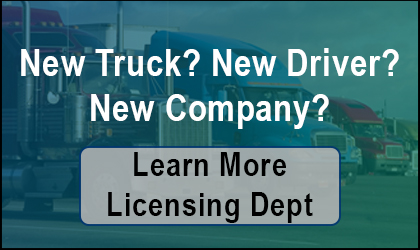An Executive Approach To Compliance Management
posted in Alerts, Newsletter by Brian Gray
All organizations are challenged with a myriad of Environmental, Health and Safety (EH&S) regulations but few industries compare to the trucking industry when it comes to the amount of regulation and severity of non-compliance. A trucking company’s very survival can depend upon its ability to manage compliance. Trucking companies are looking for ways to be compliant, reduce the cost of compliance, improve safety and still surpass corporate goals.
What are the correct steps a trucking company should take to be compliant and still operate profitably? A look into how the Best in Class companies do it can shed some light.
In a study done by the Aberdeen Group in April of 2011, titled “Compliance Management in Environment, Health, and Safety”, they found some very distinct differences in the approach to compliance between Best In Class companies to those they deemed as Laggards.
In their study of the data, the researchers found Best In Class (top 20%) companies shared similar results:
- -12% change in regulatory citations vs. previous year
- .03 recordable injury frequency rate
- 1% repeat accident rate
- +9% performance vs energy goals
- +13% operating profit vs corporate plan.
Laggards (bottom 30%) were common with these results:
- +2% change in regulatory citations vs. previous year
- 6 recordable injury frequency rate
- 10% repeat accident rate
- -9% performance vs energy goals
- -12% operating profit vs corporate plan
The Best in Class were not just good in one area. They were able to effectively manage compliance performance, safety, energy use, and profitability. They were not only able to create safer and more compliant companies but are also able to gain a competitive edge through higher operational efficiencies at a reduced cost.
What were the common characteristics companies with Best in Class performance shared?
- The Best in Class are almost 50% more likely than Laggards to have business processes that are standardized, auditable and transparent across the entire organization.
- The Best in Class are over twice as likely as Laggards to automatically collect EH&S data from across the organization.
- The Best in Class are more than three times likely as Laggards to use subscription software for managing regulatory content.
So, what does a company need to do to move its compliance performance from Laggard to Average or Average to Best In Class? The Aberdeen Group researchers found that companies must do the following:
- Most importantly, build compliance into the business process. Move compliance from a “cost of doing business, check the box” attitude to an integrated part of managing the business by establishing policies that continuously improve compliance. Establishing standardized, auditable and transparent processes so everyone does it the same way and can be measured along the way.
- Streamline the reporting process to everyone involved with your organization. Make compliance visible. Streamlining compliance generally requires a data base that stores relevant compliance information and incorporates an efficient method for reporting the information throughout the organization. Best In Class companies look to create/improve visibility throughout their operations by investing in compliance management, reporting, dashboards and analytics.
- Automate the collection of EH&S data. 59% of Best in Class companies had automated software systems to collect the data vs only 23% of Laggards. Having the data enables intelligent decision making, improves visibility and promotes accountability.
If you operate trucks, compliance with environmental, health, and safety regulations must be more than just words. It must become an attitude ingrained into the culture of your company. Technology use in regulatory enforcement is shinning an ever brighter light on the Laggards and the penalty for those not improving will be severe. The one thing to remember is this: the cost of compliance increases in direct proportion to the length of time that compliance decisions are put off. Delay is a decision — for the wrong way.
IRS Heavy Vehicle Use Tax Deadline Approaches
Someone once said that the only things certain in life were death and taxes. One of life’s certainties is quickly approaching in the form of the IRS required Heavy Vehicle Use Tax (HVUT). Based on the findings of the American Association of State Highway Officials (AASHO) road test, damage caused by heavy trucks was 160,000 times more damaging to a road surface than a 0.5 ton car. The heavy vehicle use tax is a fee assessed annually on heavy vehicles operating on public highways at registered gross weights equal to or exceeding 55,000 pounds. The funds collected through the Heavy Vehicle Use Tax are invested back into our nation’s transportation infrastructure to help repair the damage.
Each HVUT tax year runs from July 1st through June 30th of the following year. The deadline to file and pay the tax to the IRS without penalty is August 31. The form for filing the tax is form 2290, making sure to use the correct year version. The correct 2290 form should read for the tax year 2012-2013. The forms are generally made available each July by the IRS.
The IRS is responsible for HVUT collections and taxpayer audits. States are required to obtain proof of HVUT payments when registering heavy trucks subject to the tax. Some State’s will not renew truck registrations without proof at the time of registration. Some Sate’s will allow a short grace period in which to fax the State a copy of the proof. However, if the deadline is not met, license plates can be suspended.
Carriers trying to evade paying HVUT fees have been a significant problem, costing millions in lost road repair revenue. HVUT evasion penalties are significant, resulting in fines and incarceration, as illustrated in one 2001 HVUT evasion case. An owner of a small trucking company was found guilty of HVUT evasion by periodically re-titling his heavy vehicles into different names specifically to avoid paying the fees. The owner of the trucking company was sentenced to serve four months in prison with an additional four months of electronically monitored home confinement and a $2,000 fine.
For more information you can go to the IRS website at www.irs.gov and search for form 2290. If you have questions or would like help filing your 2290, give Glostone Trucking Solutions a call at 503-607-1088.








